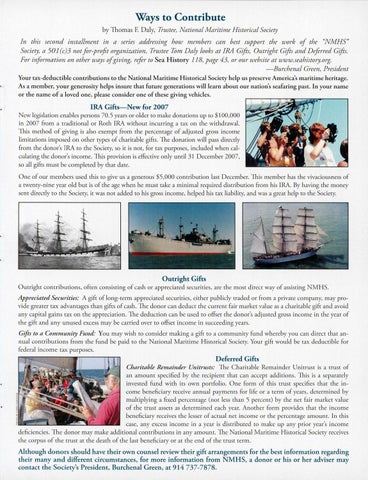Ways to Contribute by Thomas F. Daly, Trustee, National Maritime Historical Society
In this second installment in a series addressing how members can best support the work of the "NMHS" Society, a 501 (c)3 not for-profit organization, Trustee Tom Daly Looks at IRA Gifts, Outright Gifts and Deferred Gifts. For information on other ways ofgiving, refer to Sea History 118, page 43, or our website atwww.seahistory.org. -Burchenal Green, President Your tax-deductible contributions to the National Maritime Historical Society help us preserve America's maritime heritage. As a member, your generosity helps insure that future generations will learn about our nation's seafaring past. In your name or the name of a loved one, please consider one of these giving vehicles.
IRA Gifts-New for 2007 New legislation enables persons 70.5 years or older to make donations up to $100,000 in 2007 from a traditional or Roth IRA without incurring a tax on the withdrawal. This method of giving is also exempt from the percentage of adjusted gross income limitations imposed on other types of charitable gifts. The donation will pass directly from the donor's IRA to the Society, so it is not, for tax purposes, included when calculating the donor's income. This provision is effective only until 31 December 2007, so all gifts must be completed by that date. One of our members used this to give us a generous $5,000 contribution last December. This member has the vivaciousness of a twenty-nine year old but is of the age when he must take a minimal required distribution from his IRA. By having the money sent directly to the Society, it was not added to his gross income, helped his tax liability, and was a great help to the Society.
Outright Gifts Outright contributions, often consisting of cash or appreciated securities, are the most direct way of assisting NMHS.
Appreciated Securities: A gift of long-term appreciated securities, either publicly traded or from a private company, may provide greater tax advantages than gifts of cash. The donor can deduct the current fair market value as a charitable gift and avoid any capital gains tax on the appreciation. The deduction can be used to offset the donor's adjusted gross income in the year of the gift and any unused excess may be carried over to offset income in succeeding years. Gifts to a Communhy Fund¡ You may wish to consider making a gift to a community fund whereby you can direct that annual contributions from the fund be paid to the National Maritime Historical Society. Your gift would be tax deductible for federal income tax purposes. Deferred Gifts Charitable Remainder Unitrusts: The Charitable Remainder Unitrust is a trust of an amount specified by the recipient that can accept additions. This is a separately invested fund with its own portfolio. One form of this trust specifies that the income beneficiary receive annual payments for life or a term of years, determined by multiplying a fixed percentage (not less than 5 percent) by the net fair market value of the trust assets as determined each year. Another form provides that the income beneficiary receives the lesser of actual net income or the percentage amount. In this case, any excess income in a year is distributed to make up any prior year's income deficiencies. The donor may make additional contributions in any amount. The National Maritime Historical Society receives the corpus of the trust at the death of the last beneficiary or at the end of the trust term. Although donors should have their own counsel review their gift arrangements for the best information regarding their many and different circumstances, for more information from NMHS, a donor or his or her adviser may contact the Society's President, Burchenal Green, at 914 737-7878.
